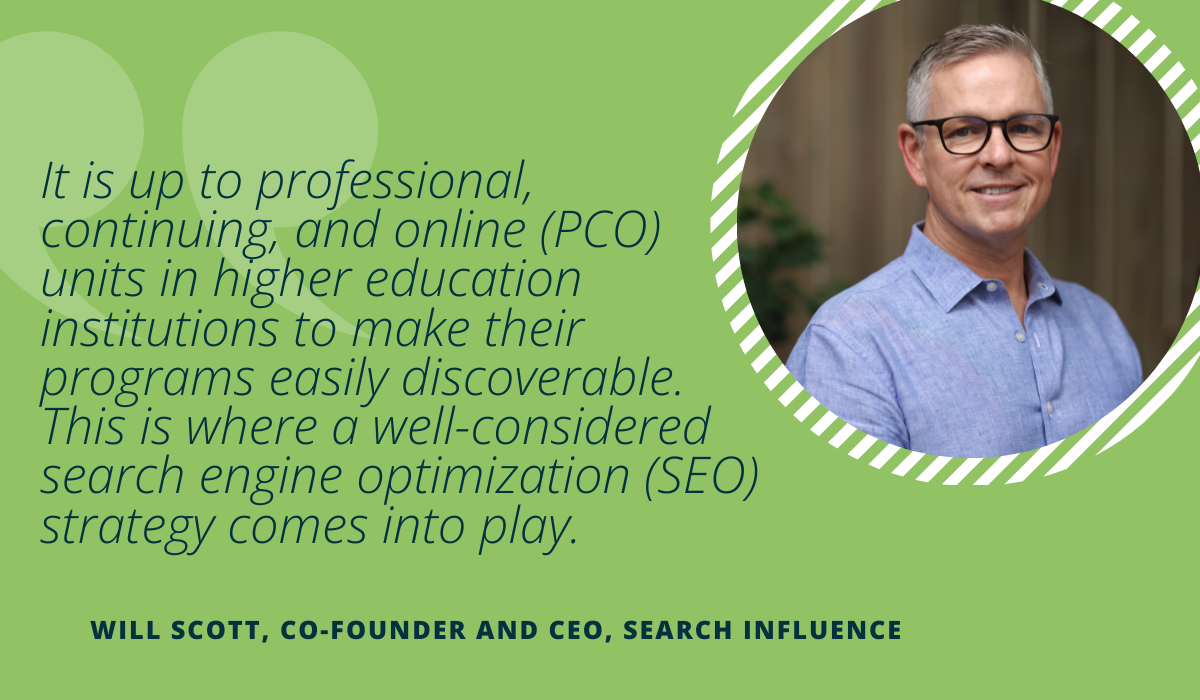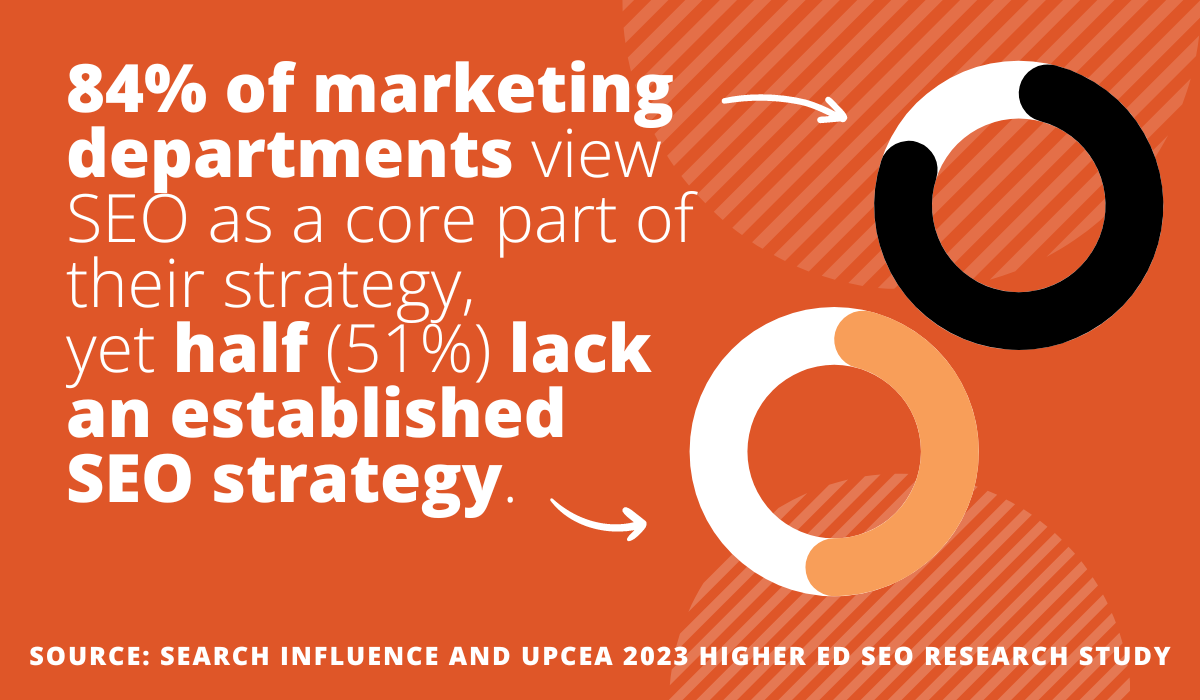Industry Insights
Valuable insights from UPCEA's trusted corporate partners.
Drive Success: Using Recruitment SEO to Fill Higher Education Seats
Summary
Higher education marketers must adapt to the changing ways learners discover and explore educational programs. Ensuring institutions are easily discoverable requires an effective SEO strategy to boost brand visibility and engagement. Learn how.

Higher education marketing teams face a critical challenge: adapting to how learners now discover and explore educational programs.
From the first touchpoint to application completion, marketers must ensure a seamless experience for prospective students and maintain their presence throughout the enrollment funnel.
This makes recruitment SEO more important now than ever before.
With fewer high school graduates, higher education needs to redefine its perception of the “ideal student.” Despite numerous challenges, according to Inside Higher Ed, 77% of college presidents express confidence in their institution’s financial stability over the next decade. However, this optimism overlooks rising costs, potential consolidation, faculty retention issues, diversity concerns, and inflation.
Additionally, many university presidents hesitate to fully embrace online courses, a potential lifeline in the digital education era.
The sector also faces a “demographic cliff” — a decline in the number of 18-22-year-olds over the next two decades, potentially resulting in an annual shortfall of up to one million students.
Adult and non-traditional students present both opportunities and challenges to higher education institutions. They juggle financial obligations, work, family commitments, and the self-confidence needed to return to school. They may not be aware that colleges and universities can help them achieve their personal and professional goals.

It is up to professional, continuing, and online (PCO) units in higher education institutions to make their programs easily discoverable. Departments must consider learners who haven’t yet decided to return to school, offering resources on learning, careers, and job advancement.
This is where a well-considered search engine optimization (SEO) strategy comes into play.
SEO involves improving a website’s rankings in search engines for relevant queries. For higher ed websites, effective SEO can:
- Place you on the consideration list for those seeking degree, program, or certificate information.
- Help interested prospects find information about your school more quickly.
- Drive interest from prospects not yet considering education as a solution to their life challenges.
However, as our higher ed marketing research with UPCEA revealed, many colleges and universities lack the SEO skills and strategies needed to move prospects through their marketing funnel. Consequently, schools miss out on capturing qualified prospects from search.
While social media and other marketing tools contribute to recruitment, search has a broader reach. A 2019 BrightEdge study found that 68% of online experiences begin with a search engine — a number likely higher today. This underscores the crucial role of SEO in the discovery process.
Search engine ranking significantly affects users’ perception of a brand. The 2007 research study “Does It Pay to Get to the Top? Contextual Factors of Branding in Search Engine Marketing,” suggests that a lesser brand can appear more prominent based on its placement in search. Recognition of these brands increases when they appear before well-known brands in search engine results.
Clearly, if search engine ranking influences brand perception, SEO is an essential tool for higher education marketing.

From our 2023 joint SEO Research Study with UPCEA, we know that 84% of marketing departments view SEO as a core part of their strategy, yet half (51%) lack an established SEO strategy.
Imagine telling your boss about an important strategy component that you choose not to fully implement. It sounds crazy, but this is happening in higher education institutions’ marketing and recruitment offices.
This assumes that marketing teams even know how to implement an effective higher ed SEO strategy.
A well-executed higher education SEO strategy yields better results, regardless of budget and department size. SEO is critical because it provides high visibility to target audiences and helps convert and move individuals down the recruitment funnel.
It’s not enough to view SEO as a discovery tool. Prospective students often conduct subsequent searches for additional information and validation. The more frequently your institution appears in these searches, the more credible it seems.
Your absence in search results not only benefits your competitors but also undermines the goodwill you’ve built.
If potential students can’t find your institution where they search (SEO), how will this impact your long-term strategy to fill seats?
Why don’t marketers focus enough on SEO?
- PCO units lack sufficient human or financial resources for SEO.
- Many institutional leaders (deans, directors) are unaware of SEO efforts and are less likely to support resource allocation (48% don’t receive regular updates on important SEO metrics.)
- There is a lack of in-depth internal knowledge and skills about SEO.
In our SEO Research study, marketing leaders rated their unit’s SEO skills an average of 3.5 on a 1–5 scale, just slightly above average. Unfortunately, with a shrinking market, average results may not suffice.
The study, which included audits of 100 UPCEA Member sites, found that many schools’ websites are underutilized as recruitment tools. The average grade assigned was a D, highlighting significant room for improvement.
For a detailed analysis, check out the full report here.
BONUS: If you’d like to increase your chances of reaching the new adult learner, check out our free SEO Workbook for beginner-friendly strategy tips and tricks.
Will Scott is a recognized leader in digital marketing, known for coining the phrase “barnacle SEO” in 2008. Will is frequently invited to present at marketing and other industry conferences. Will founded Search Influence in 2006 with his wife, Angie Scott. Since putting his first website online in 1994, Will has led teams responsible for creating thousands of websites for business, building hundreds of thousands of pages in online directories, and delivering millions of visits from search. At Search Influence, Will directs the teams of dedicated professionals who optimize your potential! Outside of work, Will is a father to two boys, husband to Angie, his co-founder and COO in Search Influence. He is active in local non-profit and civic causes, an Ironman athlete, and a recovering heart patient.
